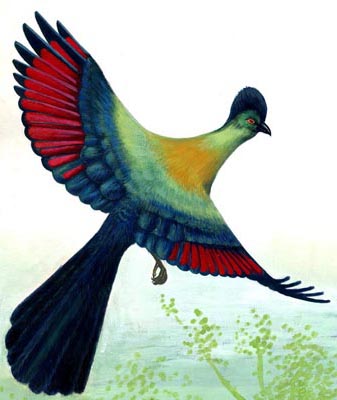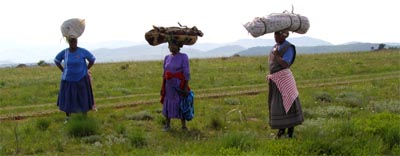The ENTC now has a new website, at www.entc.org.sz
Our logo is adapted from a painting by Phillip Dlamini, 1998, of a purple crested turaco. In traditional Swazi dress, the red feathers feature in the royal headdress, so this bird illustration is not only a symbol for wildlife conservation, but also of cultural heritage.


(Updated March 2008, information from Sandile Gumedze, additional information 2019.)
This is a collaborative project, involving traditional medicinal practitioners, the ENTC and the Eswatini Homeopathy Project. The initiative was begun in 2015, initially focussing on Warburgia salutaris (Pepperbark tree, sibhaha), then on Siphonochilus aethiopicus (African ginger, sidvungolo), and currently on Alepidea cordifolia (previously known as Alepidea amatymbica, likhatsato). The selection of the species for this project was determined by the opinions of the traditional medicinal practitioners, based on scarcity and desirability.
It is expected that more of the traditional medicinal practitioners in the communities surrounding Malolotja will be involved with the likatsato project, as this is a highveld species.
More information on the Endangered Medicinal Plants Project.
The Malolotja community Outreach Programme started operating in 1994.
Malolotja Nature Reserve is surrounded by a total of 13 Communities, namely; Nkaba, Mhlosheni, Majotini, Malanti, kaNdeva, Malanti, Luvinjelweni, kaShoba, Mlondozi, Phasengwenya, Hawane, And Malolotja.
This programme is intended to improve relations with surrounding communities by offsetting the limitations on resource use within the reserve that are inherent in Protected Area (PA) Management.
The COP officer identifies appropriate community development projects, secures their funding from development agencies, and facilitates their implementation.

The COP Programme is housed together with the Environmental Education Programme at the Malolotja EEC.
The Community Outreach Officer (COP) is always available upon request (informal and formal) to assist Community Based Organisationsations (CBO’s), Schemes, and individuals on the above work programme areas.
Our Contacts:
Head Quarters: (+268) 2416 1489/1179
Email: info@sntc.org.sz
King Sobhuza II Park: (+268) 2416 1489/1179
Email: ksmp@sntc.org.sz
National Museum: (+268) 2416 1489/1179
Email: curator@sntc.org.sz
Copyright © ESWATINI NATIONAL TRUST COMMISSION
Malolotja Nature Reserve: (+268) 2444 3241 / (+268) 2416 1480
Email: culturalvillage@sntc.org.sz
Mantenga Nature Reserve and Swati Cultural Village: 2416 1151/1178
Email: culturalvillage@sntc.org.sz
Mlawula Nature Reserve: (+268) 2383 8885 (Reception)
(+268) 2383 8453 (Senior Warden)
Email: culturalvillage@sntc.org.sz
Magadzavane Lodge: (+268) 2343 5108/9
Email: magadzavane@sntc.org.sz